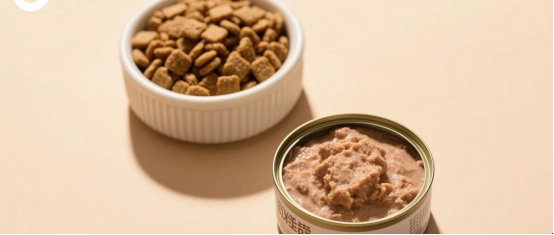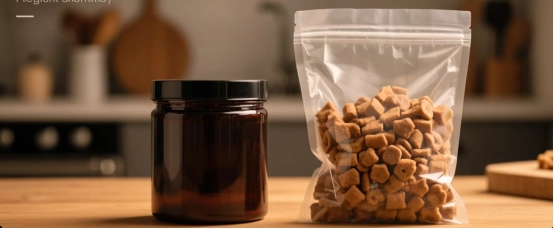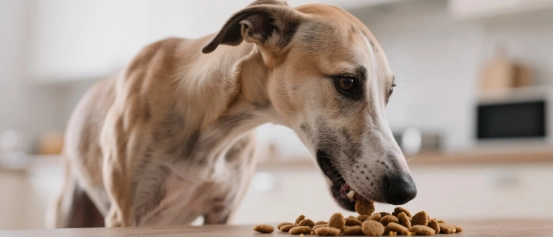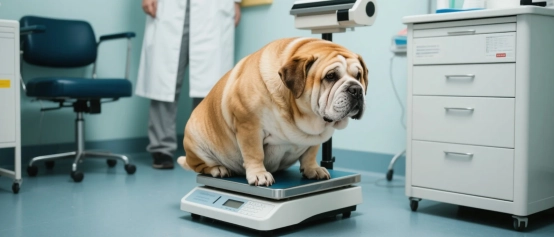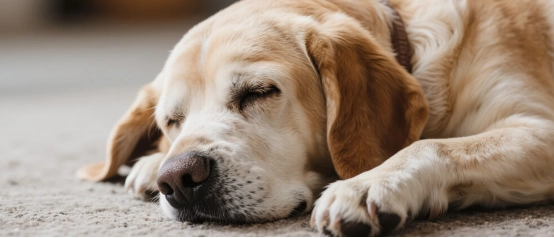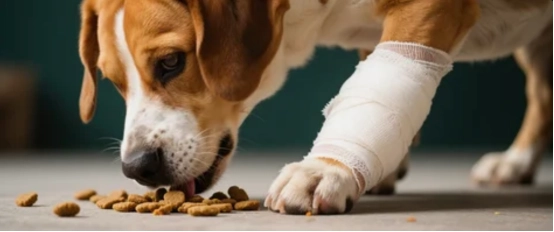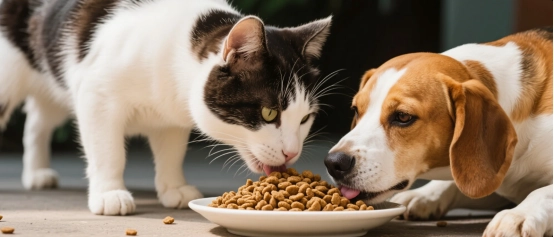
Many pet owners with both dogs and cats wonder if it's safe for their pets to eat each other's food, especially when curious pets sneak a bite from the wrong bowl. While a single nibble of cat food won't harm a dog, or vice versa, regular consumption of the other's food can lead to nutritional imbalances or health issues. This article explores the differences between dog and cat food, the risks of cross-feeding, considerations for occasional consumption, and practical tips to manage multi-pet households.
Dogs and cats have distinct dietary needs due to their differing physiology and evolutionary backgrounds. Dogs are omnivores, capable of digesting a mix of animal and plant-based foods, while cats are obligate carnivores, requiring a diet primarily of animal tissue to thrive. These differences are reflected in the formulations of dog and cat food.
Cat food is typically higher in protein and fat to meet the needs of obligate carnivores. It contains 30%-40% protein, often from animal sources like chicken or fish, and 20%-30% fat, providing the high energy cats need. Cat food also includes specific nutrients like taurine, an essential amino acid for cats, which supports heart and eye health. Cats cannot synthesize taurine, so it's added to their food. Additionally, cat food has higher levels of arachidonic acid (a fatty acid) and vitamin A, which cats require in greater amounts than dogs.
Dog food, by contrast, is formulated for omnivores, with 20%-30% protein and 10%-20% fat, depending on the brand and purpose (e.g., maintenance or performance). It includes more carbohydrates, often from grains or vegetables like rice or sweet potatoes, to provide energy. Dog food lacks supplemental taurine, as dogs can produce it naturally, and has lower levels of vitamin A and certain fatty acids, as dogs don't need them in the same quantities.
These differences mean that neither dog nor cat food is optimized for the other species. Feeding a dog cat food long-term can lead to excess protein and fat intake, while feeding a cat dog food can result in deficiencies of critical nutrients like taurine.
Occasional bites of cat food won't seriously harm most dogs, but regular consumption poses several risks. First, the high protein and fat content in cat food can strain a dog's digestive system, leading to vomiting, diarrhea, or pancreatitis, especially in dogs unaccustomed to rich diets or those with sensitive stomachs. Second, the high calorie density of cat food (often 400-500 kcal/cup compared to 300-400 kcal/cup for dog food) can cause rapid weight gain, increasing the risk of obesity and related issues like joint problems or diabetes. Third, excessive vitamin A from cat food can lead to toxicity in dogs over time, causing symptoms like bone pain or lethargy. For dogs with specific health conditions, such as kidney or liver disease, the high protein levels in cat food can exacerbate their condition.
Puppies are particularly vulnerable, as their developing systems may struggle to process the rich nutrients in cat food, potentially leading to developmental issues. Additionally, some cat foods contain ingredients like propylene glycol (in certain semi-moist foods), which is safe for cats but potentially harmful to dogs in large amounts.
Cats face more severe risks from eating dog food regularly due to their strict nutritional requirements. Dog food lacks sufficient taurine, and a taurine-deficient diet can lead to serious health problems in cats, including heart disease (dilated cardiomyopathy) or vision loss (retinal degeneration). These conditions may take weeks or months to develop but can be irreversible if not addressed. Dog food also has lower protein and fat levels, which may leave cats feeling hungry or lead to muscle loss and poor coat quality over time. The higher carbohydrate content in dog food is less digestible for cats, who lack the enzymes to efficiently process plant-based nutrients, potentially causing digestive upset or nutrient deficiencies.
Even occasional consumption of dog food can disrupt a cat's balanced diet, especially for kittens, pregnant cats, or those with health conditions, as their nutritional needs are more precise. Long-term, a cat eating dog food may become malnourished, even if they appear to maintain weight, due to missing key nutrients.
A single instance of a dog eating cat food or a cat eating dog food is unlikely to cause harm, provided the pet is healthy and the amount is small. For example, a dog stealing a few kibbles of cat food during a meal won't likely suffer more than mild digestive upset, if anything. Similarly, a cat nibbling dog food once won't immediately develop deficiencies. However, pet owners should monitor their pets for signs of distress, such as vomiting, diarrhea, or lethargy, and contact a veterinarian if symptoms persist.
The context matters—occasional cross-feeding is riskier for pets with pre-existing conditions, young animals, or those with specific dietary needs. For instance, a diabetic dog eating high-calorie cat food could experience blood sugar spikes, while a kitten eating dog food might miss critical nutrients for growth. If cross-feeding happens frequently, even in small amounts, it can gradually unbalance the pet's diet, leading to subtle health issues over time.
Preventing dogs and cats from eating each other's food requires proactive management in multi-pet households. First, feed pets in separate areas. For example, feed the cat on a high counter or in a room with a pet gate that the dog can't access, while feeding the dog on the floor or in a crate. This physical separation reduces temptation and ensures each pet eats their own food. Second, establish a feeding schedule rather than free-feeding. Remove uneaten food after 15-20 minutes to prevent scavenging. If free-feeding is necessary for one pet (e.g., a cat with grazing habits), use a microchip-activated feeder that only opens for the intended pet.
Store dog and cat food separately in airtight containers to maintain freshness and prevent mix-ups. Label containers clearly to avoid accidentally serving the wrong food. If you catch a pet eating the other's food, gently redirect them to their own bowl rather than scolding, as stress can worsen sneaky eating habits. For persistent cross-feeders, consult a veterinarian or pet behaviorist to address underlying issues, such as food obsession or anxiety.
Monitor your pets' health regularly. Weigh them monthly to check for unexpected weight gain (in dogs eating cat food) or loss (in cats eating dog food), and watch for changes in coat quality, energy levels, or stool consistency. Annual vet checkups can detect early signs of nutritional imbalances, such as taurine deficiency in cats or kidney strain in dogs.
Some pet owners believe dog and cat food are interchangeable because they look similar or are made by the same brands, but this overlooks their tailored formulations. Others assume that because their pet seems to enjoy the other's food, it's safe, ignoring long-term nutritional risks. Another misconception is that adding supplements can compensate for feeding the wrong food—while supplements like taurine can help cats, they don't address the full spectrum of imbalances. Finally, don't assume all pets tolerate cross-feeding equally; individual health, age, and size influence the risks.
While a dog eating cat food or a cat eating dog food occasionally is unlikely to cause serious harm, regular cross-feeding can lead to nutritional deficiencies, obesity, or other health issues due to the distinct needs of each species. Understanding the differences between dog and cat food, recognizing the risks, and managing feeding in multi-pet households are key to keeping both pets healthy. By feeding each pet their species-specific diet and preventing access to the other's food, you ensure they receive the nutrients they need to thrive, supporting their long-term well-being and happiness.
